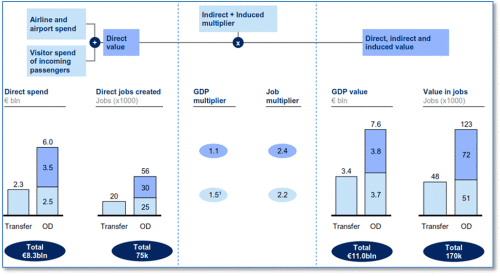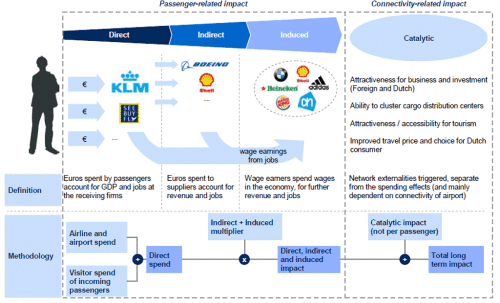Air traffic not only creates direct jobs, but it also creates job opportunities in other sectors. In 2010, McKinsey and the Boston Consulting Group calculated that air traffic at Schiphol generated 75,000 direct jobs and contributed €8.3 billion to GDP. However, the total number of jobs – including indirect employment – amounted to 170,000 jobs with a €11 billion contribution to GDP.

The above figures also include the tourism expenditure of 2,544 million foreign travellers arriving in the Netherlands by air. For the purpose of this Job Market Analysis, only the direct impact of air transport on aviation itself has been calculated, with the effects on the tourism and conference industries having been omitted. This also applies to the indirect and derivative impact on suppliers and other sectors.
Besides employment generated by air traffic, many jobs in the Netherlands are created through the network of air travel connections providing opportunities for Dutch companies and attracting foreign companies to the Netherlands. This type of employment is called catalytic employment.

The catalytic employment arising from aviation in the Netherlands is a direct consequence of the exceptional network of air routes offered by the country. Excellent accessibility by air makes the Netherlands an international hub for people, goods, money and information. As a result, the Randstad conurbation, in particular, serves an excellent base for international service provision. By this we mean the provision of business, logistics and financial services, trade, floriculture, the petrochemical industry, as well as the creative and non-profit sectors. For example, 60% of the international trade in cut flowers passes through the Netherlands. Around 75% of imported goods (around €750 million) are carried by air. Moreover, since the 1980s, half of all US and 60% of all Japanese multinationals, such as Nissan, Caterpillar and Microsoft, have opened a distribution centre or a European head office close to Amsterdam, thanks in part to easy accessibility by air. Currently, a similar influx of foreign companies, mainly from China and India, is taking place. For example, Huawei has recently established its European head office in Amsterdam.